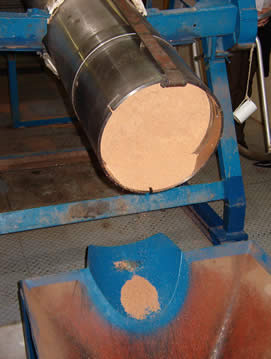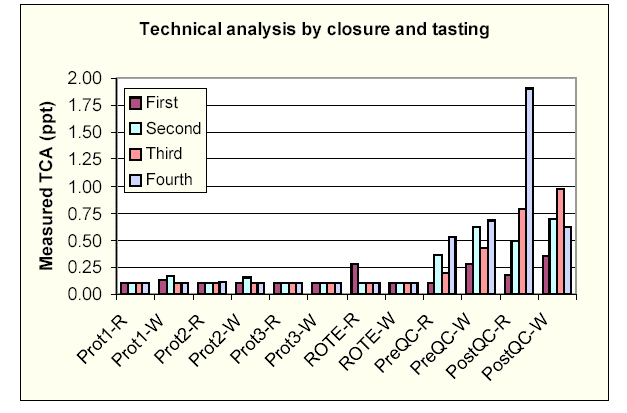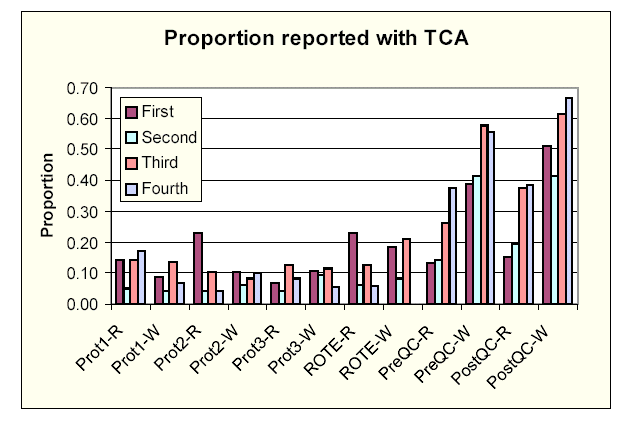
|
Grain
of Truth [This article
originally appeared in Harper's
Wine and Spirit Weekly 15
November 2002, Pages 32-36,
and is reproduced here with permission. I
thought it would be worth archiving this on the internet because as
well as providing useful data on the performance of the closures
tested, the study also contributes significant information about the
human perception of TCA.] By the end of the 1990s, Sabaté’s Altec closure was widely criticised for unacceptable levels of taint. After modifications, the French manufacturer invited experts from the trade and press to test the performance of its old and new closures. Jamie Goode analyses the research model’s openness, methodology and its surprising results Never begin with an apology. This is one piece of advice that
budding writers and public speakers would do well to adhere to, but
I’m going to disregard it this time. In fact, I’ll start with two.
First, I apologise for the fact that this is yet another piece on cork
taint. It continues to be one of the most important and divisive
issues facing the wine trade, albeit one which many have prematurely
grown weary of. My second apology concerns the necessarily technical
nature of some of the issues discussed here. But please don’t let
this deter you from reading further, because this article represents
the first public airing of some extremely important data from a
rigorously conducted research study, shedding light not only on the
performance of a particular closure type, but also on the nature of
human perception of the cork taint culprit, 2,4,6 trichloroanisole (TCA).
The study in question was commissioned by French company
Sabaté, the world’s second largest closure manufacture. As well as
making conventional corks, Sabaté’s portfolio includes the Altec, a
fully manufactured and standardized cork-based closure. Launched in
1995, the Altec represented a novel approach to alternative closures.
The problem it addressed was the dissatisfaction of wine producers
with the performance of the inexpensive corks that they were using for
their mass-market wines. Because of perceived consumer resistance to
plastic corks and screwcaps – particularly strong in the French
market – Sabaté devised a manufacturing process that produced what
is in effect a hybrid closure: part cork, part synthetic, but which
looks like a natural product. This manufacturing process involves taking raw cork and
fragmenting it into tiny particles. These are then sorted and most of
the lignin – the hard, woody material that surrounds the lenticels
(the tiny pores in the cork) – is discarded. This cork ‘flour’
is then blended with proprietary polymer microspheres and the whole
lot stuck together with a binding agent. The resulting closures are
consistent, and in theory should have lower risk of TCA taint than
normal corks, because the lignin-rich material that surrounds the
lenticels is considered to harbour the majority of the TCA
contamination. Initially, the Altec was tremendously successful. Sales were
huge, and to date more than 2 billion bottles of wine have been sealed
with them. But a couple of years ago, reports began coming in that the
Altec, which had been initially marketed as being taint free, was
causing unacceptably high levels of taint. The situation was
particularly bad in the USA, where four wineries blamed Altec for
tainting large numbers of their wines. This led to legal action that
is still ongoing, with a decision due from the courts in January 2003. More bad news came from the results of the study conducted by
the Australian Wine Research Institute (AWRI). This scientifically
rigorous study is currently monitoring the performance of a number of
closure types over time, including Altec. When the 24-month results
were published they reported that each of the bottles sealed with
Altec closures were found to have a TCA-like aroma, and follow-up
chemical analysis found detectable levels of TCA in each of the Altec
samples analysed. Nicolas Serpette, communications manager of Sabaté,
confirmed that the sales of Altec in 2002 have been affected by this
adverse publicity. ‘We’ve been exposed to very negative
coverage’ he says. ‘We have lost a lot of US customers in
particular, who are now scared of using Altec.’ Sabaté’s response Their response involved three strategies. First, Sabaté
instituted a new quality control standard. Every batch of Altecs
leaving the factory was subjected to testing, and they now ensure that
no batch leaves with greater than an average TCA concentration of 3
parts per trillion (parts per trillion = nanograms per litre, ng/l –
both measures are commonly used in discussions of TCA).
To coordinate this research
effort, Sabaté hired Cube Communications, a relatively new UK-based
PR company. Cube’s James Gabbani, who was in charge of the project,
was initially unsure about whether Cube should associate themselves
with an issue that carries such a high risk of damaging fall-out.
Gabbani decided that the only way Cube would get involved was if the
‘trial was run a way that we knew was beyond reproach, so we
wouldn’t get our fingers burnt.’ He adds that, ‘Sabaté have
held to that all the way through, which is nice’. Study methodology Cube convened a star-studded panel of 15 wine industry
figures to participate in the trial and monitored its progress (Table
1). As well as helping decide on the study methodology, the panel
chose two wines from a selection available, one white and one red,
which were then bottled using a variety of closures (Table 2). The
procedure used for analysis was largely based on the methods used by
the AWRI in their benchmark closure trial. Chemical analysis of 2600 bottles for TCA was carried out by
the Campden and Chorleywood Food Research Organization (CCFRA) using
solid-phase microextraction and gas chromatography/mass spectrometry
to a tolerance of 0.2 ppt. Cube emphasize that no other study has been
carried out on this scale assessing TCA down to such a minutely low
concentration. 528 of these bottles were also tasted by the panel to
compare the actual versus perceived TCA occurrence. These tastings
were spread over four sessions at three-monthly intervals. When wines
were tasted, CCFRA staff were on hand to take two samples from each
bottle, which were then sealed in individual glass capsules with foil
caps, transported to the lab and analysed with minimal delay. The raw
data were passed on to an academic statistician, Russell Gerrard of
the City of London University, for analysis. Table 1 Panel members
Table 2 Closure types used in the study
Rates of taint: how the closures performed Both the pre- and post-quality control Altecs show some TCA
contamination of both the red and white wines. Interestingly, the
post-quality control Altecs have higher levels of TCA than the
pre-quality control Altecs which caused all the problems for Sabaté
in the first place. Is this bad news for Sabaté? It depends. If you
look at the levels of TCA involved, they are extremely low -- well
below 2 ppt. For the post-quality control Altecs, it is clear that
they meet the new standard of <3 ppt. With the pre-quality control
corks, the likelihood is that the batch used in this study is a good
one, and not one of those likely to have caused the taint problems
Altec has become associated with. I asked Nicolas Serpette about this,
but he was unable to discuss the taint rates Sabaté found in
pre-quality control batches of Altecs because of ongoing legal action
in the USA. Evidently, though, with the current standard of 3 ppt,
some batches with higher TCA levels are not now leaving the factory,
but previously would have.
Figure 1. Concentration of TCA detected by the technical
analysis, arranged by closure type (see Table 2 for key) and by wine
type (R, red; W, white). ‘First’, ‘second’, ‘third’ and
‘fourth’ relate to the four separate tasting sessions, held at
three-month intervals.
Figure 2. Proportion of bottles tasted reported by the
panel to have TCA, arranged by closure type (see Table 2 for key) and
by wine type (R, red; W, white). ‘First’, ‘second’,
‘third’ and ‘fourth’ relate to the four separate tasting
sessions, held at three-month intervals. Taster thresholds for TCA? In short, no. One of the significant general findings from
this study is that the data across all tasters show that the notion of
a threshold for TCA is not tenable. Russell Gerrard, the statistician
who analysed the findings states that ‘the proportion of bottles
identified as containing TCA increases steadily as the measured TCA
content increases, rather than jumping from a lower value to a higher
as the TCA content passes some cut-off point’. Gerrard’s statistical analysis reveals some interesting
findings, summarised in Table 3. These show that half of tasters will
detect TCA when it is present at 1.2 ppt in white wines and 2.5 ppt in
red wines. Three quarters will detect it when it is present at 2.07
ppt in whites and 3.93 ppt in reds. Bear in mind though that even for
this expert group of tasters, for both red and white wines there was
more than a 10% chance of them detecting TCA when there was none
present, itself a rather startling statistic.
These figures correlate quite well with some other recent
data on TCA detection and recognition from the Wine and Spirit
Association’s (WSA’s) Musty Flavour Defects in Wine Survey.
Although not a focus of the WSA’s study, the published report
provides some measurements of the participants’ sensory thresholds
for TCA in white wine, looking at the thresholds for both detection
(when participants could spot something was wrong with the wine) and
recognition (when they could identify the flaw as TCA). The average
values for these were 1.5 ppt (range 0.5–10 ppt) and 6.5 ppt (range
2.5–20 ppt), respectively, for 28 participants spread over two
sessions. What does this say about Sabaté’s decision to set their
batch quality control level at 3 ppt TCA? For white wines, the data
from the current study suggest that the vast majority of tasters would
report a wine with 3 ppt TCA as being tainted. For reds, it would be
just over half. But bear in mind that the tasters in this study were
all experts who were actively looking for TCA. The fact that they were
calling clean wines tainted more than 10% of the time suggests they
were being over-zealous in diagnosing slight differences in the
samples as TCA even when they are not detecting any mustiness. At each
session they were simultaneously assessing dozens of samples of the
same two wines, red and white, and so any differences would be
immediately apparent. It would be interesting to see the same data
gathered with a range of different wines, and with a non-expert group
who are not actively looking for TCA. TABLE 3 Chance of reporting TCA related to actual TCA
content, aggregated over all tasters and closures
The difference between whites and reds Conclusions In the meantime, what of the post-quality control Altecs? It
seems that without the CO2 extraction step, it is
inevitable that cork-based products such as Altec will have a residual
level of TCA. It is not clear whether this level is problematic.
Sabate are convinced that the current taint levels are not
significant, and will cause no problems. However, the data here on
taster detection limits show that wine industry professionals actively
looking for TCA in Altec-sealed wines report its presence in
approximately 35% of reds and up to 60% of whites, albeit with a high
false positive rate. In the absence of further data, wine producers
will have to decide for themselves whether they consider this to be a
significant risk for their products.
A question mark surrounds whether this level of TCA would be
noticeable by the consumer. One key question that remains to be answered is how well
Altecs perform in terms of permeability. Are they as effective as
screwcaps in retaining freshness over time? In this respect it’s a
shame that the current study didn’t involve measurements of free SO2
levels, a relatively simple test. The AWRI trial found that decline in
free SO2 is a useful surrogate measure for oxidation, and
that small differences in SO2 concentrations at early
stages are strong predictors of differences in later sensory
performance. The sensory analysis carried out in the tasting component
of this study looked at subjective measures of freshness, fruit and
finish, and indicated that the Altecs performed well in comparison
with screwcaps. These data are backed up by the measurements of free
SO2 in the AWRI trial at the 30 month time point, where
Altecs performed as well as screwcaps and better than both the
synthetic and natural corks in the study. In closing, these are clearly important data, answering some
questions and raising others. Credit is due to both to Sabaté, for
the openness with which they have conducted this study and released
the data, and also to Cube, for overseeing a scientifically rigorous
study and ensuring proper statistical treatment of the results. Could
this be a new dawn for the cork industry? |


